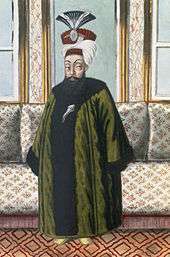Nakşidil Sultan
| Nakşidil Sultan | |
|---|---|
| Valide Sultan of the Ottoman Empire | |
| Tenure | 28 July 1808 – 22 August 1817 |
| Predecessor | Sineperver Sultan |
| Successor | Bezmiâlem Sultan |
| Born |
Unknown c. 1768 Caucasus , possibly Georgia |
| Died |
22 August 1817 (aged 48–49) Constantinople, Ottoman Empire |
| Burial | Türbe of Nakşidil Sultan, Fatih Mosque, Istanbul, Turkey |
| Spouse | Abdul Hamid I |
| Issue |
Mahmud II Şehzade Murad Saliha Sultan |
| Religion | Orthodox Christian at birth, subsequently converted to Islam after her capture |
Nakşidil Sultan (fully Devletli, İsmetli, Nakşidil Valide Sultan Aliyyetü'ş-şân Hazretleri; c. 1767 – 22 August 1817; meaning "Embroidered on the Heart"[1])[2] was the consort of Ottoman Sultan Abdul Hamid I and Valide Sultan to her son Mahmud II.
Background
According to the Ottoman Chronicles, the mother of Mahmud II was known by the Turkish name Nakşidil (Nakshidil) and died in 1817; all the women of the sultan's harem were given Turkish names.
According to various scholars, she came from a family with origins in the Caucasus region. Fikret Saraçoğlu has found in the archives of the Topkapı Palace in Istanbul documents pertaining to her death and funeral.[3] Others like Necdet Sakaoğlu and Ibrahim Pazan traced these origins further and claim she was actually a Georgian. She was raised in the Ottoman palace and was given thoroughly Turkish Islamic education.[4][5]
Influence
Nakşidil bore a son named Mahmud; whom assassins of Mustafa IV, aided by the Ulema, sought to murder; Nakşidil saved her son by concealing him, so that he lived to become the next sultan, Mahmud II, accomplishing significant reforms in society and in the military that were largely attributed to the influence of his mother.[6] Mahmud became sultan after having ordered the death of his half-brother, Mustafa IV, who had previously ordered the deaths of Mahmud II, and of their cousin, Selim III, whom he had deposed as sultan.[7]
Controversy over identity

There is a fanciful legend that she was Aimée du Buc de Rivéry, who had gone missing at sea in 1788, and was a distant cousin-in-law of the former Empress Josephine, wife of Napoleon Bonaparte. According to this myth, Aimée du Buc de Rivéry was captured by Barbary pirates and sold as a harem concubine, though there is no evidence of this.[8]
Several older myths, dating back even to the early 16th century, already purported connections between the French and the Ottoman monarchies. These have been found to be politically motivated fabrications, intended to justify alliances between the two (supposedly related) monarchies. The Aimée-Nakşidil tale shows several distinct parallels to these older tales. In times of monarchy, the stories about abducted French princesses weren't repudiated by French officials to maintain good relations with the Ottoman inventors of the tales. In later times this and similar harem tales have been used in France to perpetuate a view of Turkey, the Middle East and the Islam in general as mysterious and despotic in nature, despite more accurate accounts available.[9]
Issue
Together with Abdul Hamid, Nakşidil had three children:
See also
References
- ↑ Harem: The Favourites
- ↑ "Images du patrimoine". Manioc. Retrieved 1 September 2010.
- ↑ Turkish Daily News Archived 27 September 2007 at the Wayback Machine.
- ↑ İbrahim Pazan (2007). Padişah anneleri. Babıali Kültür Yayıncılığı. ISBN 978-9-944-11831-6.
- ↑ Sakaoğlu, Necdet (2008). Bu mülkün kadın sultanları: Vâlide sultanlar, hâtunlar, hasekiler, kadınefendiler, sultanefendiler. Oğlak Publications. pp. 358–360. ISBN 978-9-753-29623-6.
- ↑ A History of the Modern Middle East Cleveland, William L. & Burton, Martin; Fifth Edition; Westview Press; USA; 2015, p. 71. ISBN 978-0813348339.
- ↑ Encyclopædia Britannica Encyclopædia Britannica: "Mustafa IV".
- ↑ Christine Isom-Verhaaren, Royal French Women in the Ottoman Sultans' Harem: The Political Uses of Fabricated Accounts from the Sixteenth to the Twenty-first Century, Journal of World History, vol. 17, No. 2, 2006
- ↑ Christine Isom-Verhaaren: Royal French Women in the Ottoman Sultans' Harem
- 1 2 3 Sarıcaoğlu, Fikret (2001). Kendi kaleminden bir Padişahın portresi Sultan I. Abdülhamid (1774-1789). Tatav, Tarih ve Tabiat Vakfı. pp. 17–18. ISBN 978-9-756-59601-2.
External links
| Ottoman royalty | ||
|---|---|---|
| Preceded by Ayşe Seniyeperver Sultan |
Valide Sultan 28 July 1808 – 22 August 1817 |
Succeeded by Bezmiâlem Sultan |
